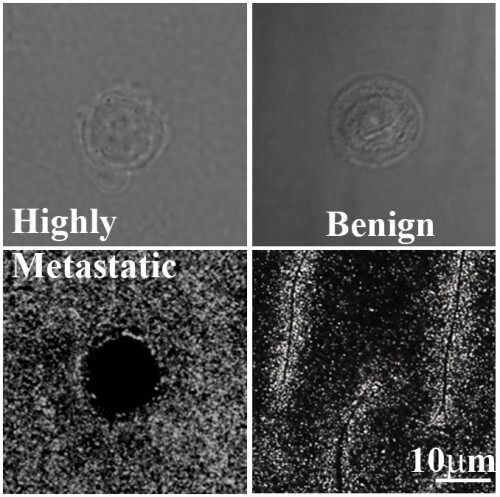This month, Israel and the world celebrate breast cancer awareness month. An innovative technology developed in the Faculty of Biomedical Engineering at the Technion will enable the prediction of the formation of cancer metastases after the outbreak of breast cancer. The technology, whose effectiveness was proven in the preliminary experiments, enters the phase of experiments in the cells of operated patients

Associate Professor Dafna Weiss recently recorded a research breakthrough: the unique technology she developed - a biomechanical method for the early detection of metastatic cancer - received the approval of the Helsinki Committee. This means that the technology, which was found to be effective in tests of cell lines, will be transferred to experiments with cells collected from tumors directly after surgery, in collaboration with the Rambam Medical Center.
According to Prof. Weiss, the applied idea is that "the system will allow the medical team to check, already during or immediately after the biopsy or surgery on the cancerous tumor, the likelihood of metastases of the tumor in other organs, and which organs are concerned." Such knowledge will make it possible to act at a very early stage to identify and stop those metastases, and moreover, to prevent the initial tumor from sending further metastases."
Cancer is a general name for a broad family of diseases - more than two hundred - which have in common the loss of control over the rate of cell division and the transformation of cells into immortals. In other words, the cancer mechanism disrupts the normal process of cell division and converts it into "wild" and rapid division. Since the cells do not age or die, the primary tumor expands, invades and takes over more and more nearby tissues. In addition, apart from its spread to the immediate environment, a particularly aggressive tumor "knows" how to send metastases to more distant tissues through the lymphatic and blood vessel systems. The metastases (secondary tumors) are usually more dangerous than the primary tumor because they are difficult to detect at first. When they are detected at a late stage, the medical treatment with them is more complicated and the medical prognosis is not good.
"Actually, most cancer-related deaths are caused by metastases and not by the primary tumor, so huge resources are invested in developing methods for their early detection," explains Prof. Dafna Weiss, "Early detection means earlier and more effective treatment. The new approach will allow early prediction of the programming for the formation of metastases and where in the body it is likely to develop. This prediction is based on identifying the biomechanics of the primary tumor cells, and does not require us to know the specific genetic makeup of the tumor."
"The cancer cell differs in its properties from a healthy cell because it strives to penetrate and take over normal tissues in order to increase the volume into which it can spread. Therefore, the cancer cells developed, during evolution (that is, during the formation of mutations), structural flexibility; Based on the properties of the healthy tissue, the cells change their properties: shape, internal structure, rigidity and more. By adjusting the forces they exert to the nature of the healthy tissue they encountered, they manage to penetrate it. It is interesting to note that the secret of cancer cells is not hardness but rather softness - the cancer cell is softer and more flexible than a healthy cell, and the metastatic cell (a cancer cell with the potential to metastasize) is even softer and more flexible. This softness allows the cells to squeeze into dense tissues, but at the same time these soft cells also know how to harden and exert great force on their environment when they want to penetrate it."
Based on a series of studies, Prof. Viss developed a unique process of XNUMXD biomechanical imaging. "In this system, we allow the tested cells to 'grasp' in dedicated gels that simulate the stiffness of healthy tissues. Monitoring the change in the shape of the cells, the internal arrangement within them and the forces they exert on the gels allows us to learn about the differences between metastatic cells and benign cells as well as identify the adaptation processes of the cells to different environments in the body. This is an essential step on the way to predicting the formation of metastases and identifying them in early stages that allow for more effective treatment."
As mentioned, following successful experiments carried out with the innovative diagnostic tool on lines of human cells, the Helsinki Committee approved preliminary tests on humans. The tests are conducted in collaboration with the Rambam Medical Center. So far the research has focused on breast cancer, and now it is expanding to pancreatic cancer and stomach cancer.
Prof. Dafna Weiss, a faculty member in the Faculty of Biomedical Engineering, completed her three degrees in the Faculty of Chemical Engineering at the Technion. After that, she went on to do a post-doctorate in the Department of Pathology at the UCLA School of Medicine in the USA. In her post-doctoral research, which was funded by NASA due to its implications for the fields of biology and medicine in space conditions, she began to work on the topic she is currently working on: cell mechanics, with an emphasis on the behavior of cancer cells.
Prof. Weiss is included in the list of the 50 most influential women in Israel for 2015, recently published by the "Lady Globes" newspaper, due to her discoveries in the field of metastatic tumor diagnosis, which constitute a "breakthrough that will save lives in the future".

2 תגובות
In any case, amazing.
Thanks !
I would also act in the context of the immune system by examining its regular monitoring (after all, it is the wall against these tumors)